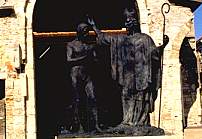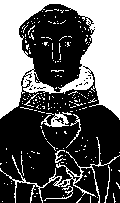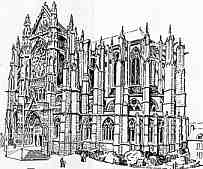 |
|
The
Content of Books |
| The
earliest surviving medieval books are works of church liturgy.
This is hardly surprising given that the reintroduction of literacy to
Europe came through the monasteries. The earliest foci of literacy were
missionising centres whose function was to convert the pagan populations
to Christianity. |
|
|
Modern
statue of the baptism of Clovis at the place where it supposedly happened
in Rheims. |
|
By
the end of the middle ages, a large array of subjects was covered in manuscript
books. Secular authors and increasing lay literacy had broadened the readership
and their interests. The written word rather than oral tradition had become
the means of transmitting much knowledge. It is tempting to suggest that
by the end of the middle ages what was found in books included everything,
but that is not quite true. |
|
The
written word was based in a tradition of writing derived from the Classical
world and a tradition of the church and its concerns with moral improvement.
These themes come through in many types of works. What is often absent, which
we take for granted today when we wander into a bookshop, is the plain observation
of the diversity of the world, its natural phenomena and its peoples. Much
practical working knowledge was also transmitted by other than the permanent
written word. |
|
We
get very superior about this and claim it is because they had not yet invented
Science, but were locked into Religious Superstition. But we know that medieval
people had a great knowledge of the natural world and its phenomena. |
|
They
grew food successfully in a range of environments. They transformed it into
bread, beer, preserved meat and fish, butter and wine. |
|
|
The
vinegrowers of Chartres are preserved in stained glass. |
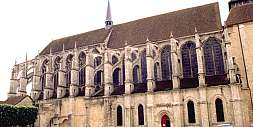 |
They spanned rivers with
bridges and built enormous and technically complex buildings. |
|
The
other major church of Chartres, St Pierre, shows the most technically advanced
form of Gothic, with a skeletal stone frame holding up glass walls. |
| They
manipulated material to make metals, glass, enamel, paints for many different
purposes, dyes for clothing. They turned animal skins into leather for
shoes and saddles or parchment for manuscripts. |
|
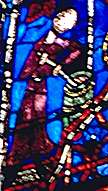 |
This
full sized bronze effigy of a 13th century bishop in Amiens cathedral represents
technical knowledge of a high order. |
|
A
Chartres tanner stirs his vat of pretty obnoxious substances known to turn
cowskin into leather. |
|
Much
of this knowledge is not preserved in detail in manuscript books. There is
no manual on How to Build a Gothic Cathedral, but the idea that
the master mason just got the workers to stick it up and see if it fell down
is nonsensical. Yes, things did occasionally fall down when they were stretching
the envelope of tolerance, but a system of knowledge was passed between experts
by some means other than the manuscript book tradition. |
|
|
Most
of Beauvais cathedral fell down, but they did try to build the tallest Gothic
vault in France. |
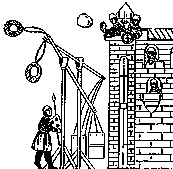 |
There
is a current craze for TV programs about ancient technology in which teams
of individuals, usually with beards, attempt to reconstruct some gizmo or
construction from the past without an instruction manual. I remember one
about the trebuchet, a machine for throwing rocks at castles. It took about
five scientists, two computers, seventeen scale models, three hundred volunteers
and twenty-seven failed attempts to finally conclude that, yes, Edward I and
his men could have accurately knocked down a Scottish castle wall with one
of those things while staying out of arrow range. I will bet you anything
that old Edward's carpenters and engineers knew that already, without a leatherbound
volume entitled The Trebuchet Builders Companion. |
|
The
point is that despite its ultimate breadth of scope, the medieval manuscript
book was confined within a tradition. It does not represent the totality
of medieval knowledge or interests or capacity to understand the world.
There are practicalities in written works, but many such matters passed
through oral tradition. It is worth considering this question of the tradition,
its exclusions and its inclusions, in relation to each of the categories
of works. |
|
|
 The
Written Word The
Written Word |
|
 |
 |
 |
 |
 |
|
 |
